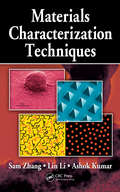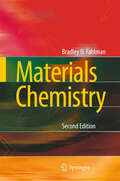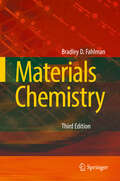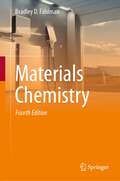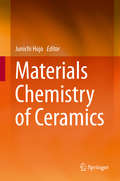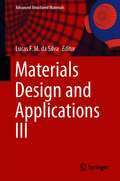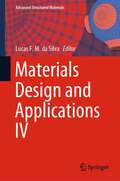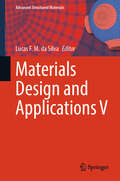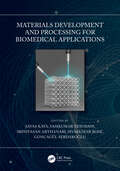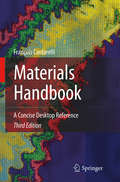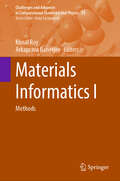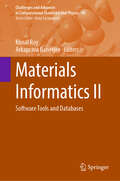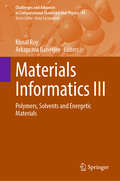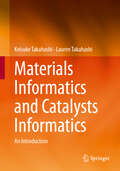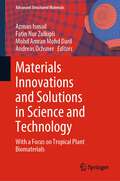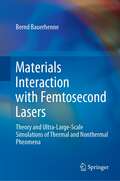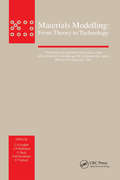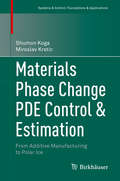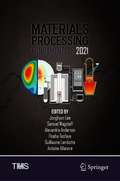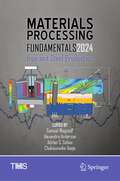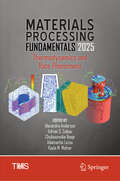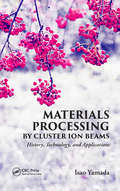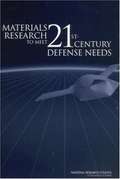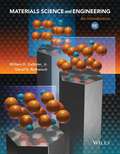- Table View
- List View
Materials Characterization Techniques
by Ashok Kumar Lin Li Sam ZhangExperts must be able to analyze and distinguish all materials, or combinations of materials, in use today-whether they be metals, ceramics, polymers, semiconductors, or composites. To understand a material's structure, how that structure determines its properties, and how that material will subsequently work in technological applications, researche
Materials Chemistry
by Bradley D. FahlmanThe 2nd edition of Materials Chemistry builds on the strengths that were recognized by a 2008 Textbook Excellence Award from the Text and Academic Authors Association (TAA). Materials Chemistry addresses inorganic-, organic-, and nano-based materials from a structure vs. property treatment, providing a suitable breadth and depth coverage of the rapidly evolving materials field -- in a concise format. The 2nd edition continues to offer innovative coverage and practical perspective throughout, e.g.: the opening solid-state chemistry chapter uses color illustrations of crystalline unit cells and digital photos of models to clarify their structures. This edition features more archetypical unit cells and includes fundamental principles of X-ray crystallography and band theory. In addition, an ample amorphous-solids section has been expanded to include more details regarding zeolite syntheses, as well as ceramics classifications and their biomaterial applications. The subsequent metals chapter has been re-organized for clarity, and continues to treat the full spectrum of powder metallurgical methods, complex phase behaviors of the Fe-C system and steels, and topics such as corrosion and shape-memory properties. The mining/processing of metals has also been expanded to include photographs of various processes occurring in an actual steelmaking plant. The semiconductor chapter addresses evolution and limitations/solutions of modern transistors, as well as IC fabrication and photovoltaics. Building on the fundamentals presented earlier, more details regarding the band structure of semiconductors is now included, as well as discussions of GaAs vs. Si for microelectronics applications, and surface reconstruction nomenclature. The emerging field of 'soft lithographic' patterning is now included in this chapter, and thin film deposition methodologies are also greatly expanded to now include more fundamental aspects of chemical vapor deposition (CVD) and atomic layer deposition (ALD). The polymer and 'soft' materials chapter represents the largest expansion for the 2nd edition. This chapter describes all polymeric classes including dendritic polymers, as well as important additives such as plasticizers and flame-retardants, and emerging applications such as molecular magnets and self-repairing polymers. This edition now features 'click chemistry' polymerization, silicones, conductive polymers and biomaterials applications such as biodegradable polymers, biomedical devices, drug delivery, and contact lenses. Final chapters on nanomaterials and materials-characterization techniques are also carefully surveyed, focusing on nomenclature, synthetic techniques, and applications taken from the latest scientific literature. The 2nd edition has been significantly updated to now include nanotoxicity, vapor-phase growth of 0-D nanostructures, and more details regarding synthetic techniques and mechanisms for solution-phase growth of various nanomaterials. Graphene, recognized by the 2010 Nobel Prize in Physics, is now also included in this edition. Most appropriate for Junior/Senior undergraduate students, as well as first-year graduate students in chemistry, physics, or engineering fields, Materials Chemistry may also serve as a valuable reference to industrial researchers. Each chapter concludes with a section that describes important materials applications, and an updated list of thought-provoking questions. The appendices have also been updated with additional laboratory modules for materials synthesis (e.g., porous silicon) and a comprehensive timeline of major materials developments.
Materials Chemistry
by Bradley D. FahlmanThe 3rd edition of this successful textbook continues to build on the strengths that were recognized by a 2008 Textbook Excellence Award from the Text and Academic Authors Association (TAA). Materials Chemistry addresses inorganic-, organic-, and nano-based materials from a structure vs. property treatment, providing a suitable breadth and depth coverage of the rapidly evolving materials field — in a concise format. The 3rd edition offers significant updates throughout, with expanded sections on sustainability, energy storage, metal-organic frameworks, solid electrolytes, solvothermal/microwave syntheses, integrated circuits, and nanotoxicity. Most appropriate for Junior/Senior undergraduate students, as well as first-year graduate students in chemistry, physics, or engineering fields, Materials Chemistry may also serve as a valuable reference to industrial researchers. Each chapter concludes with a section that describes important materials applications, and an updated list of thought-provoking questions.
Materials Chemistry
by Bradley D. FahlmanThis award-winning textbook delivers an earnest and comprehensive treatment of the rapidly evolving field of Materials Chemistry. It addresses inorganic-, organic-, and nano-based materials from a structure vs. property treatment, providing a suitable breadth and depth coverage of the field—in a concise and accessible format.The updated 4th edition features significant updates to glasses and ceramics, solid-state impurities, nanomaterial toxicity, as well as materials used in energy storage, photovoltaic, and electronics applications. Advanced fabrication techniques such as additive manufacturing (3-D printing) and dynamic light scattering (DLS) characterization of suspended nanoparticles are now also included. This new edition also expands the coverage of sustainability and life cycle analysis, of increasing importance for a world plagued with the effects of climate change.Recognized by a 2008 Textbook Excellence Award from the Text and Academic Authors Association (TAA), Fahlman’s Materials Chemistry is ideal for upper-level undergraduate students, as well as first-year graduate students in chemistry, physics, or engineering fields, and may also serve as a valuable reference to industrial researchers. Each chapter concludes with a section that describes important materials applications and an updated list of thought-provoking questions.
Materials Chemistry of Ceramics
by Junichi HojoThis book provides fundamental knowledge of ceramics science and technology in a compact volume. Based on inorganic chemistry, it is intended as a reader for graduate students and young researchers beginning work in ceramics. The importance of the book is that it provides a scientific understanding of structure, properties, and processing from the chemical aspect, leading to creation of future ceramics. Ceramics have high hardness, strength, thermal and chemical stability, as well as various electromagnetic functions. To take full advantage of ceramics, their use has been advanced to engineering and electronic ceramics. Most ceramics have been fabricated by powder processing, and new technologies have also evolved such as CVD and sol-gel methods: new ceramics aimed at new functions of highly pure oxides and artificial nitrides, carbides, and borides; fine ceramics focused on precise control of composition and microstructure; and design of unique morphology, such as nanoparticles, nanofibers, nanosheets, mesoporous materials, and hybrids. Materials are composed of atoms and molecules. They are assembled into crystals and are amorphous, leading to 3-D micro/nano structures. In addition to the topics described above, this book shows the importance of chemistry for materials design at the nanometer scale, and that chemistry develops new fields of environment, energy, informatics, biomaterials, and other areas.nojpkpo
Materials Design and Applications III (Advanced Structured Materials #149)
by Lucas F. M. da SilvaThis book offers selected contributions to fundamental research and application in designing and engineering materials. It focuses on mechanical engineering applications such as automobile, railway, marine, aerospace, biomedical, pressure vessel technology, and turbine technology. This includes a wide range of material classes, like lightweight metallic materials, polymers, composites, and ceramics. Advanced applications include manufacturing using the new or newer materials, testing methods, and multi-scale experimental and computational aspects.
Materials Design and Applications IV (Advanced Structured Materials #168)
by Lucas F. M. da SilvaThis book offers selected contributions on fundamental research and application in designing and engineering materials. It focuses on mechanical engineering applications such as automobile, railway, marine, aerospace, biomedical, pressure vessel technology, turbine technology. This includes a wide range of material classes, like lightweight metallic materials, polymers, composites, and ceramics. Advanced applications include manufacturing using the new or newer materials, testing methods, multi-scale experimental and computational aspects.
Materials Design and Applications V (Advanced Structured Materials #212)
by Lucas F. M. da SilvaThis book discusses several issues relevant to materials design and applications. The focus is on fundamental research and application areas in the field of the design and application of engineering materials, predominantly within the context of mechanical engineering applications. This includes a wide range of materials engineering and technology, including metals, e.g., lightweight metallic materials, polymers, composites, and ceramics. Advanced applications include manufacturing of new materials, testing methods, multi-scale experimental and computational aspects. The book publishes selected papers presented at the 5th International Conference on Materials Design and Applications 2024 (MDA 2024), held during July 4–5, 2024.
Materials Development and Processing for Biomedical Applications
by Savaş Kaya Sasikumar Yesudass Srinivasan Arthanari Sivakumar Bose Goncagül SerdaroğluMaterials Development and Processing for Biomedical Applications focuses on various methods of manufacturing, surface modifications, and advancements in biomedical applications. This book examines in detail about five different aspects including, materials properties, development, processing, surface coatings, future perspectives and fabrication of advanced biomedical devices. Fundamental aspects are discussed to better understand the processing of various biomedical materials such as metals, ceramics, polymers, composites, etc. A wide range of surface treatments are covered in this book that will be helpful for the readers to understand the importance of surface treatments and their future perspectives. Additional Features Include: Examines various properties of biomedical materials at the beginning in several chapters which will enrich the fundamental knowledge of the readers. Discusses advancements in various fields of biomedical applications. Provides a glimpse of characterization techniques for the evaluation of material properties. Addresses biocompatibility, biocorrosion, and tribocorrosion. This book explores new and novel strategies for the development of materials and their biomedical applications. It will serve as a comprehensive resource for both students and scientists working in materials and biomedical sciences.
Materials Handbook: A Concise Desktop Reference
by François CardarelliThe unique and practical Materials Handbook (third edition) provides quick and easy access to the physical and chemical properties of very many classes of materials. Its coverage has been expanded to include whole new families of materials such as minor metals, ferroalloys, nuclear materials, food, natural oils, fats, resins, and waxes. Many of the existing families—notably the metals, gases, liquids, minerals, rocks, soils, polymers, and fuels—are broadened and refined with new material and up-to-date information. Several of the larger tables of data are expanded and new ones added. Particular emphasis is placed on the properties of common industrial materials in each class. After a chapter introducing some general properties of materials, each of twenty classes of materials receives attention in its own chapter. The health and safety issues connected with the useand handling of industrial materials are included. Detailed appendices provide additional information on subjects as diverse as crystallography, spectroscopy, thermochemical data, analytical chemistry, corrosion resistance, and economic data for industrial and hazardous materials. Specific further reading sections and a general bibliography round out this comprehensive guide. The index and tabular format of the book makes light work of extracting what the reader needs to know from the wealth of factual information within these covers. Dr. François Cardarelli has spent many years compiling and editing materials data. His professional expertise and experience combine to make this handbook an indispensable reference tool for scientists and engineers working in numerous fields ranging from chemical to nuclear engineering. Particular emphasis is placed on the properties of common industrial materials in each class. After a chapter introducing some general properties of materials, materials are classified as follows. ferrous metals and their alloys; ferroalloys; common nonferrous metals; less common metals; minor metals; semiconductors and superconductors; magnetic materials; insulators and dielectrics; miscellaneous electrical materials; ceramics, refractories and glasses; polymers and elastomers; minerals, ores and gemstones; rocks and meteorites; soils and fertilizers; construction materials; timbers and woods; fuels, propellants and explosives; composite materials; gases; liquids; food, oils, resin and waxes; nuclear materials. food materials
Materials Informatics I: Methods (Challenges and Advances in Computational Chemistry and Physics #39)
by Kunal Roy Arkaprava BanerjeeThis contributed volume explores the integration of machine learning and cheminformatics within materials science, focusing on predictive modeling techniques. It begins with foundational concepts in materials informatics and cheminformatics, emphasizing quantitative structure-property relationships (QSPR). The volume then presents various methods and tools, including advanced QSPR models, quantitative read-across structure-property relationship (q-RASPR) models, optimization strategies with minimal data, and in silico studies using different descriptors. Additionally, it explores machine learning algorithms and their applications in materials science, alongside innovative modeling approaches for quantum-theoretic properties. Overall, the book serves as a comprehensive resource for understanding and applying machine learning in the study and development of advanced materials and is a useful tool for students, researchers and professionals working in these areas.
Materials Informatics II: Software Tools and Databases (Challenges and Advances in Computational Chemistry and Physics #40)
by Kunal Roy Arkaprava BanerjeeThis contributed volume explores the application of machine learning in predictive modeling within the fields of materials science, nanotechnology, and cheminformatics. It covers a range of topics, including electronic properties of metal nanoclusters, carbon quantum dots, toxicity assessments of nanomaterials, and predictive modeling for fullerenes and perovskite materials. Additionally, the book discusses multiscale modeling and advanced decision support systems for nanomaterial risk management, while also highlighting various machine learning tools, databases, and web platforms designed to predict the properties of materials and molecules. It is a comprehensive guide and a great tool for researchers working at the intersection of machine learning and material sciences.
Materials Informatics III: Polymers, Solvents and Energetic Materials (Challenges and Advances in Computational Chemistry and Physics #41)
by Kunal Roy Arkaprava BanerjeeThis contributed volume focuses on the application of machine learning and cheminformatics in predictive modeling for organic materials, polymers, solvents, and energetic materials. It provides an in-depth look at how machine learning is utilized to predict key properties of polymers, deep eutectic solvents, and ionic liquids, as well as to improve safety and performance in the study of energetic and reactive materials. With chapters covering polymer informatics, quantitative structure–property relationship (QSPR) modeling, and computational approaches, the book serves as a comprehensive resource for researchers applying predictive modeling techniques to advance materials science and improve material safety and performance.
Materials Informatics and Catalysts Informatics: An Introduction
by Keisuke Takahashi Lauren TakahashiThis textbook is designed for students and researchers who are interested in materials and catalysts informatics with little to no prior experience in data science or programming languages. Starting with a comprehensive overview of the concept and historical context of materials and catalysts informatics, it serves as a guide for establishing a robust materials informatics environment. This essential resource is designed to teach vital skills and techniques required for conducting informatics-driven research, including the intersection of hardware, software, programming, machine learning within the field of data science and informatics. Readers will explore fundamental programming techniques, with a specific focus on Python, a versatile and widely-used language in the field. The textbook explores various machine learning techniques, equipping learners with the knowledge to harness the power of data science effectively. The textbook provides Python code examples, demonstrating materials informatics applications, and offers a deeper understanding through real-world case studies using materials and catalysts data. This practical exposure ensures readers are fully prepared to embark on their informatics-driven research endeavors upon completing the textbook. Instructors will also find immense value in this resource, as it consolidates the skills and information required for materials informatics into one comprehensive repository. This streamlines the course development process, significantly reducing the time spent on creating course material. Instructors can leverage this solid foundation to craft engaging and informative lecture content, making the teaching process more efficient and effective.
Materials Innovations and Solutions in Science and Technology: With a Focus on Tropical Plant Biomaterials (Advanced Structured Materials #173)
by Andreas Öchsner Azman Ismail Mohd Amran Mohd Daril Fatin Nur ZulkipliThis book offers innovative ideas and solutions from tropical fruits and crops for engineering problems. It covers a wide range of topics related to science, engineering, and technologies. The topics shared in this book enable practitioners and innovators to develop subsequent novel ideas and methods for solving engineering and technological problems for organizations to sustain its operation in global challenges.
Materials Interaction with Femtosecond Lasers: Theory and Ultra-Large-Scale Simulations of Thermal and Nonthermal Pheomena
by Bernd BauerhenneThis book presents a unified view of the response of materials as a result of femtosecond laser excitation, introducing a general theory that captures both ultrashort-time non-thermal and long-time thermal phenomena. It includes a novel method for performing ultra-large-scale molecular dynamics simulations extending into experimental and technological spatial dimensions with ab-initio precision. For this, it introduces a new class of interatomic potentials, constructed from ab-initio data with the help of a self-learning algorithm, and verified by direct comparison with experiments in two different materials — the semiconductor silicon and the semimetal antimony.In addition to a detailed description of the new concepts introduced, as well as giving a timely review of ultrafast phenomena, the book provides a rigorous introduction to the field of laser–matter interaction and ab-initio description of solids, delivering a complete and self-contained examination of the topic from the very first principles. It explains, step by step from the basic physical principles, the underlying concepts in quantum mechanics, solid-state physics, thermodynamics, statistical mechanics, and electrodynamics, introducing all necessary mathematical theorems as well as their proofs. A collection of appendices provide the reader with an appropriate review of many fundamental mathematical concepts, as well as important analytical and numerical parameters used in the simulations.
Materials Modelling: From Theory to Technology
by EnglishIn Materials Modelling: From Theory to Technology, a distinguished collection of authors has been assembled to celebrate the 60th birthday of Dr. R. Bullough, FRS and honor his contribution to the subject over the past 40 years.The volume explores subjects that have implications in a wide range of technologies, focusing on how basic research can be applied to real problems in science and engineering. Linking theory and technology, the book progresses from the theoretical background to current and future practical applications of modeling. Accessible to a diverse audience, it requires little specialist knowledge beyond a physics degree. The book is useful reading for postgraduates and researchers in condensed matter, nuclear engineering, and physical metallurgy, in addition to workers in R&D laboratories and the high technology industry.
Materials Phase Change PDE Control & Estimation: From Additive Manufacturing to Polar Ice (Systems & Control: Foundations & Applications)
by Miroslav Krstic Shumon KogaThis monograph introduces breakthrough control algorithms for partial differential equation models with moving boundaries, the study of which is known as the Stefan problem. The algorithms can be used to improve the performance of various processes with phase changes, such as additive manufacturing. Using the authors' innovative design solutions, readers will also be equipped to apply estimation algorithms for real-world phase change dynamics, from polar ice to lithium-ion batteries.A historical treatment of the Stefan problem opens the book, situating readers in the larger context of the area. Following this, the chapters are organized into two parts. The first presents the design method and analysis of the boundary control and estimation algorithms. Part two then explores a number of applications, such as 3D printing via screw extrusion and laser sintering, and also discusses the experimental verifications conducted. A number of open problems and provided as well, offering readers multiple paths to explore in future research.Materials Phase Change PDE Control & Estimation is ideal for researchers and graduate students working on control and dynamical systems, and particularly those studying partial differential equations and moving boundaries. It will also appeal to industrial engineers and graduate students in engineering who are interested in this area.
Materials Processing Fundamentals 2021 (The Minerals, Metals & Materials Series)
by Jonghyun Lee Antoine Allanore Guillaume Lambotte Fiseha Tesfaye Samuel Wagstaff Alexandra AndersonThis volume covers various aspects of the fundamentals, synthesis, analysis, design, monitoring, and control of metals, materials, and metallurgical processes and phenomena. Topics represented include but are not limited to: • Experimental, analytical, physical, and computer modeling of physical chemistry and thermodynamics • Modeling of the transport phenomena in materials processing and metallurgical processes involving iron, steel, nonferrous metals, and composites • Second-phase particles in metals and processes and the fundamentals (experimental studies or theoretical studies) on the nucleation, growth, motion, and removal of these particles from the molten metal or reactors • Physical chemistry, thermodynamics, and kinetics for the production and refining of rare-earth metals • Control of industrial processes in the field of extraction and processing of metals and materials
Materials Processing Fundamentals 2024: Iron and Steel Production (The Minerals, Metals & Materials Series)
by Adrian S. Sabau Samuel Wagstaff Alexandra Anderson Chukwunwike IloejeThis collection covers various aspects of the fundamentals, synthesis, analysis, design, monitoring, and control of metals, materials, and metallurgical processes and phenomena. This volume will focus on the fundamentals of iron and steel production including ladle processing, casting, rolling, forging, and subsequent surface treatments. Topics represented include, but are not limited to: • Use of artificial intelligence or big data in the control or optimization of industrial processes • Modelling or optimization of recycle streams and scrap loops • Measurement and control in hostile environments • Modeling transport phenomena in materials processing and metallurgical processes involving iron, steel, nonferrous metals, and composites • Thermodynamics, kinetics, and physical chemistry of materials processes and modelling thereof
Materials Processing Fundamentals 2025: Thermodynamics and Rate Phenomena (The Minerals, Metals & Materials Series)
by Adrian S. Sabau Alexandra Anderson Adamantia Lazou Chukwunwike Iloeje Kayla M. MolnarThis collection covers first principle and applied studies of thermodynamics and rate-governed phenomena including reaction kinetics and meso-, macro-scale transport of mass, momentum, and energy throughout the sequence of processing operations. Topics represented include but are not limited to: Thermodynamic modeling for the optimization of alloy solutions, slag compositions, and other types of materials Mass and energy balance simulations of material processing systems using software such as FactSage, MPE, HSC-SIM, and METSIM Experimental and numerical studies on kinetic rate theories pertaining to crucial material processes such as chemical reactions, diffusion, nucleation and phase transformations, and solidification Numerical modeling and simulation, such as computational fluid dynamics (CFD), of multi-scale transport phenomena in unit operations Development and application of process simulations that utilize a combination of thermodynamic, kinetic, and transport equations to simulate and/or control individual unit operations and/or plants
Materials Processing by Cluster Ion Beams: History, Technology, and Applications
by Isao YamadaMaterials Processing by Cluster Ion Beams: History, Technology, and Applications discusses the contemporary physics, materials science, surface engineering issues, and nanotechnology capabilities of cluster beam processing. Written by the originator of the gas cluster ion beam (GCIB) concept, this book:Offers an overview of ion beam technologies, f
Materials Research to Meet 21st-century Defense Needs
by National Research CouncilIn order to achieve the revolutionary new defense capabilities offered by materials science and engineering, innovative management to reduce the risks associated with translating research results will be needed along with the R&D. While payoff is expected to be high from the promising areas of materials research, many of the benefits are likely to be evolutionary. Nevertheless, failure to invest in more speculative areas of research could lead to undesired technological surprises. Basic research in physics, chemistry, biology, and materials science will provide the seeds for potentially revolutionary technologies later in the 21st century.
Materials Science And Engineering: An Introduction
by David G. Rethwisch William D. CallisterMaterials Science and Engineering, 9th Edition provides engineers with a strong understanding of the three primary types of materials and composites, as well as the relationships that exist between the structural elements of materials and their properties. The relationships among processing, structure, properties, and performance components for steels, glass-ceramics, polymer fibers, and silicon semiconductors are explored throughout the chapters.
Materials Science and Fuel Technologies of Uranium and Plutonium Mixed Oxide
by Masato Kato Masahiko MachidaMaterials Science and Fuel Technologies of Uranium and Plutonium Mixed Oxide offers a deep understanding of MOX properties for nuclear fuels that will be useful for performance evaluation. It also reviews fuel property simulation technology and an irradiation behavior model required for performance evaluation. Based on research findings, the book investigates various physical property data in order to develop MOX fuel for sodium-cooled fast reactors. It discusses a database of MOX properties, including oxygen potential, melting temperature, the lattice parameter, sound speeds, thermal expansion, thermal diffusivity, oxygen self-diffusion, and chemical diffusion coefficients, that was used to derive a science-based model of MOX properties (Sci-M Pro) for fuel-performance code development. Features: Concisely covers the essential aspects of MOX nuclear fuels. Explores MOX nuclear fuels by systematically evaluating various physical property values using a behavior model. Presents fuel property simulation technology. Considers oxygen potential, the lattice parameter, sound speeds, and oxygen self-diffusion. Discusses melting temperature, thermal expansion, thermal diffusivity, and chemical diffusion coefficients. The book will be useful for researchers and engineers working in the field of nuclear fuels and nuclear materials.
